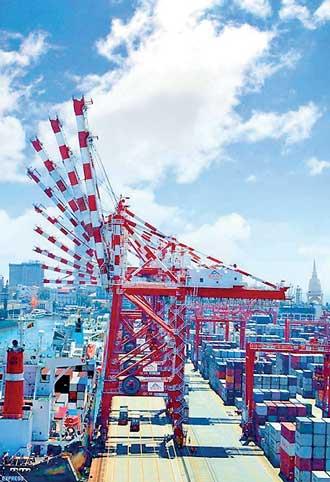Reply To:
Name - Reply Comment
By Nishel Fernando
 The transshipment volumes declined for the second straight month in June this year, as some services rerouted to avoid the heavy congestion at the Port of Colombo.
The transshipment volumes declined for the second straight month in June this year, as some services rerouted to avoid the heavy congestion at the Port of Colombo.
In June, the transshipment volumes handled by the port declined by 5.1 percent year-on-year (YoY) to 516,742 of 20-foot equivalent units (TEUs), after recording the first decline in the previous month for this year. There was also a noticeable 20.1 percent YoY decline in the number of container ships calling at the Port of Colombo in June.
“The port yard is operating above full capacity, which has led to inter-terminal delays. This has resulted in an overall decline at the Port of Colombo. Earlier, the transshipment cargo, which was cleared out in a week, now faces delays up to 21 days,” an industry source told Mirror Business.
The overall transshipment volumes grew by 9.6 percent YoY to 3.19 million TEUs in the first half of this year, driven by a double-digit growth recorded during the first four months of the year.
Earlier this year, Maersk, one of the largest ocean carriers, warned on a possible scenario leading to capacity constraints. Maersk Sri Lanka and Maldives Country Manager Biju Ravi in February urged the authorities to take the required measures to improve the efficiency to overcome the possible capacity constraints, to fully benefit from the incoming transshipment traffic caused by the Red Sea crisis.
In June, the overall container throughput at the Port of Colombo also declined by 0.9 percent YoY to 634,854 TEUs.
In the month, the import container (laden) volumes were up by 28.9 percent YoY to 44,609 TEUs, while the export container (laden) volumes were up by 4.5 percent YoY to 22,089 TEUs. The restowing volumes at the port jumped by 58.5 percent YoY to 21,908 TEUs in the month.
The port’s only fully operational deep container terminal, Colombo International Container Terminal (CICT), handled 272,577 TEUs during the year, down by 4 percent from a year ago.
The ports such as Nhava Sheva Port and Mundra Port in the sub-continent region seem to be benefiting from the heavy congestion at the Port of Colombo.
In a recent meeting with the Sri Lanka Ports Authority (SLPA), the industry stakeholders proposed to move some of the import cargo out of the port as a medium-term solution.
Several years ago, there was a proposal to move out 50 percent of import cargo out of the port to Veyangoda and Ratmalana on rail, to clear out space for transshipment cargo. The industry stakeholders pointed out that this could also result in reduced congestion in Colombo, with a marked decline in the number of container trucks coming to the port to pick up the import cargo.
However, the SLPA is not keen on this proposal at the moment, due to the investment requirements and as it cannot be implemented in the short run.
The SLPA seems to be counting on capacity expansion expected from West Container Terminal, which is set to come into partial operation by the end of this year. Moreover, the SLPA expects additional capacity after completion of the crane installations at East Container Terminal.